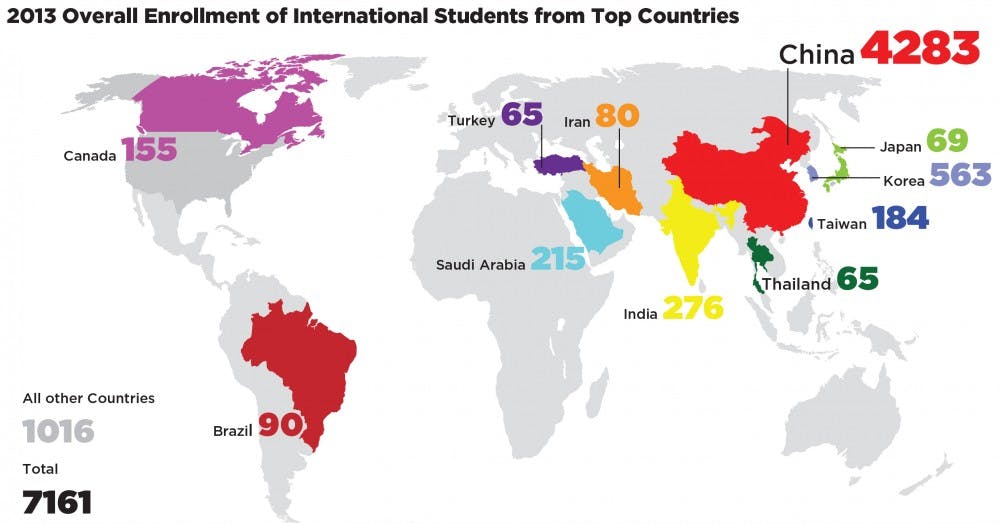Throughout the past 10 years, international student enrollment at MSU has seen stagnation and in many cases, even decline, with one big exception — China.
Data compiled by The State News from the Office for International Students and Scholars illustrates how students from the booming country have come to dominate the composition of MSU’s international student body by sheer numbers alone.
The meteoric rise of Chinese students at MSU reflects broader trends, only much more dramatically, exhibiting growth significantly above national and state averages. In particular, the influx of undergraduates from the world’s most populous nation has been the primary, if not sole, driver of MSU’s international enrollment growth since undergraduate students from abroad first eclipsed international graduate students in 2009.
There is no clear answer as to why MSU has been the recipient of this many Chinese students, but it is apparent that conditions at the university are particularly congenial to students from the world’s second-largest economy.
China’s ascension
Nationally, Chinese international enrollment has almost doubled since 2009, surpassing India with close to 200,000 Chinese students now studying in the U.S., even as many other countries have decreased in enrollment.
In 2004, there were 44 Chinese undergraduates at MSU, making up just 4.4 percent of MSU’s undergraduate enrollment from abroad. This fall, 3,458 students comprise 76.5 percent of that population.
Including graduate students, students from China now make up 61.2 percent of overall international enrollment, compared to Michigan’s statewide average of 34.2 percent. Patricia Croom, associate director for international admissions for the university, said MSU is involved only in “minimal recruitment” in China, raising questions about what makes MSU especially appealing to Chinese students looking abroad.
Comparatively, the University of Michigan saw close to a four-fold increase of about 1,600 students over the same ten-year period, while MSU’s Chinese population increased eight-fold. However, U-M’s admissions standards are more selective.
Rahul Choudaha, director of research at World Education Services, a non-profit organization that analyzes international education trends, led research at WES that sorted the types of students going abroad into four categories.
“We identified Chinese as more likely to be ‘explorers,’ which means students with high financial resources but low academic preparedness,” he said. “That is also the segment of students who typically bypass the national entrance exam, (students) call it Gaokao, with the very clear intention that they have the financial resources to directly go abroad to study.”
Peter Briggs, director of the Office for International Students and Scholars, said Indiana University and Ohio State University, institutions with rankings and admissions rates closer to MSU’s, also underwent similar increases in Chinese enrollment.
Unmet domestic demand
China, as an emerging economic superpower, has seen the percentage of college-age individuals in higher education increase from 1.4 percent in 1978 to more than 20 percent in the 21st century, MSU economics professor Lisa Cook said.
“Within 20 years, (the Chinese government) lifted 200 million people out of poverty,” Cook said. “It’s continuing on that trajectory.”
Cook said the stream of students leaving the country represents an effort by China to educate students that their own institutions don’t have the capacity to enroll.
Chinese parents are deciding earlier to prepare their child for higher education in the United States with things like studying English, Croom said. She said the trend is on the rise in part because of increasingly intense competition.
“The spaces in higher-ranked, more highly respected Chinese universities are limited,” Croom said. “It’s sort of viewed that if you can get into the top universities in China, that’s great. If you can’t, the next choice is to come to the United States.”
Space at Chinese universities “is just insufficient to meet the needs of the country,” Briggs said. The prestige of U.S. institutions provides significant appeal.
“The U.S. has the best higher education system in the world and I think it’s pretty well known,” he said.
Support student media!
Please consider donating to The State News and help fund the future of journalism.
Rankings count
During his college search, computer science sophomore Haiyang Hong compared Chinese and U.S. universities, deciding that the U.S. had a better academic environment. But when he first heard of MSU, it was in a list of rankings.
“I heard that MSU is in the top 100, so I chose to come here,” Hong said.
Choudaha pointed to two major factors that increase the appeal of U.S. universities to students abroad.
“There is clearly an established rank affinity," he said. "When people are looking to study abroad, there is a clear ranking aspiration that a lot of Chinese families want to go after, and that’s where MSU of course ranks higher, it has a degree of reputation and a diversity of programs it offers.”
The second part, he said, is social networks or the influence of where their friends choose to enroll.
Hong said last year friends in China asked him about MSU, looking for advice about where to attend. Hong lauded the university, praising the friendliness of the students and the university’s international perspective. They’re now freshmen.
Supply chain management junior Ge Li said after she applied to her top schools, she looked at online rankings for schools that would accept her test scores and found MSU.
Of the three schools she applied to, she was accepted to two. In the end, MSU had the better ranking and weather more like her hometown, Beijing.
“My family and I think that the universities in China are less stressful,” Li said. “We don’t have to do much work and the materials that we learn wouldn’t be very useful when we go to work in the future.”
For an interactive look at changes in enrollment, click here.
Discussion
Share and discuss “International Expansion” on social media.







